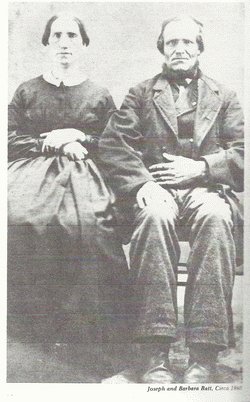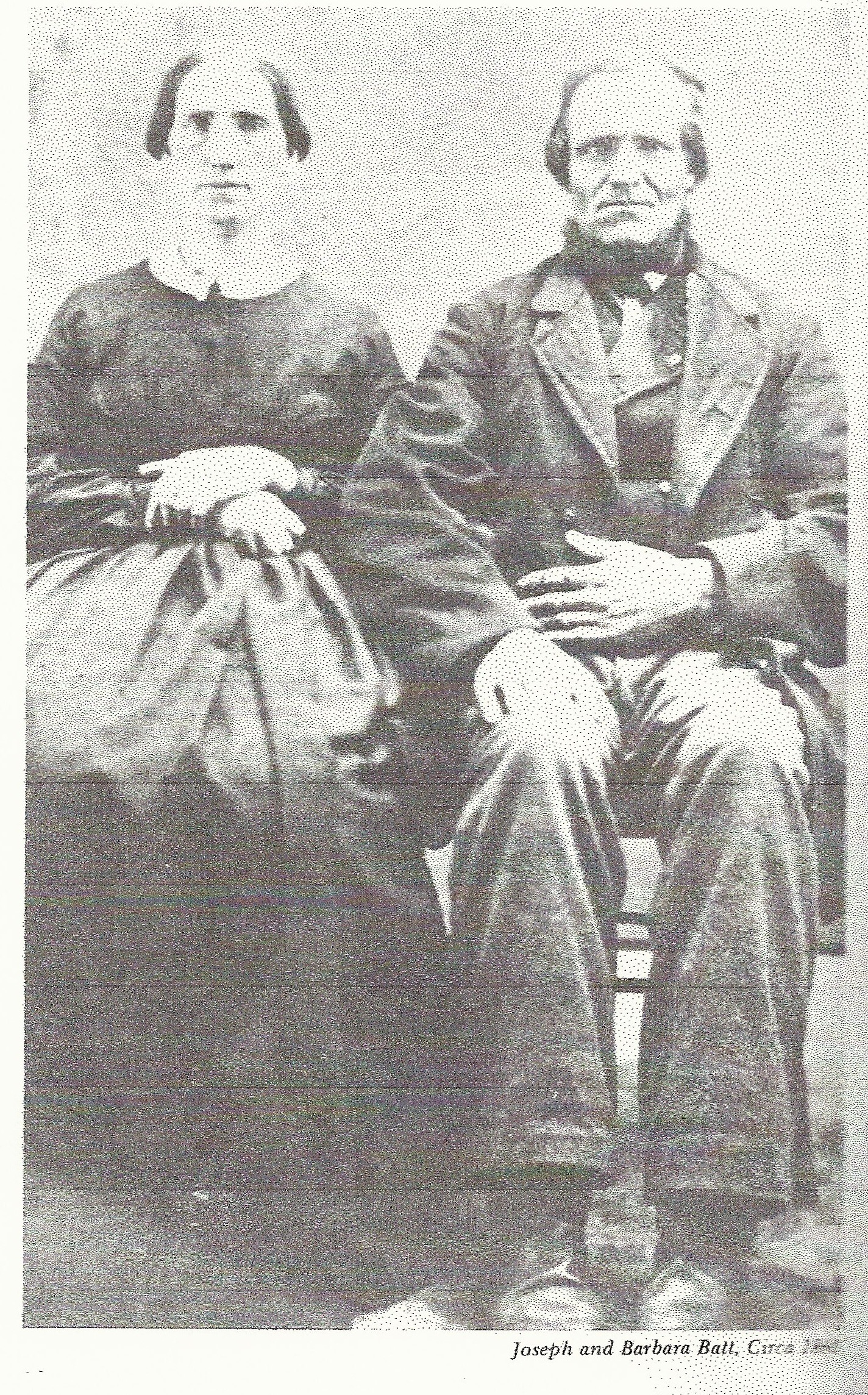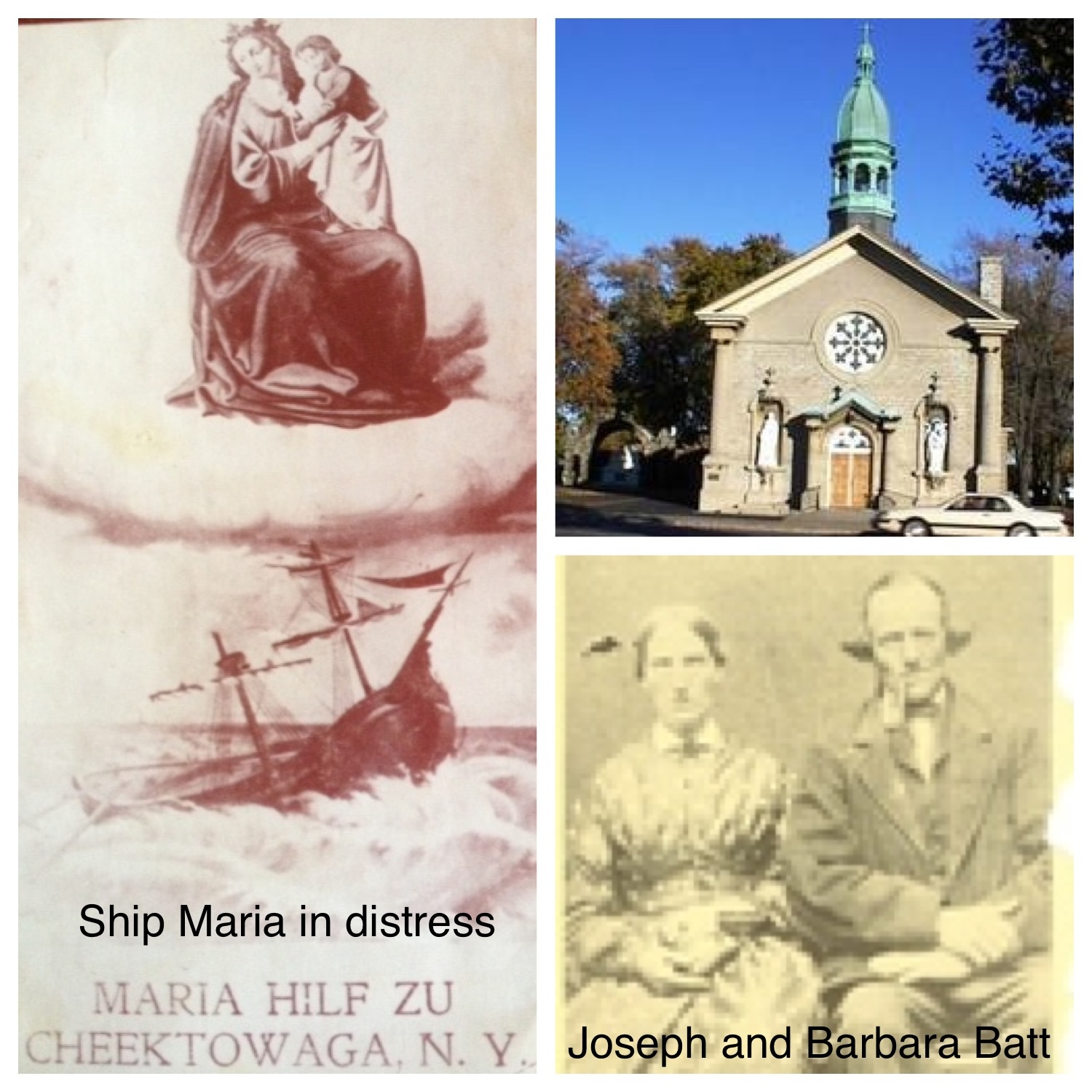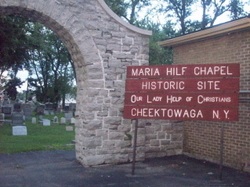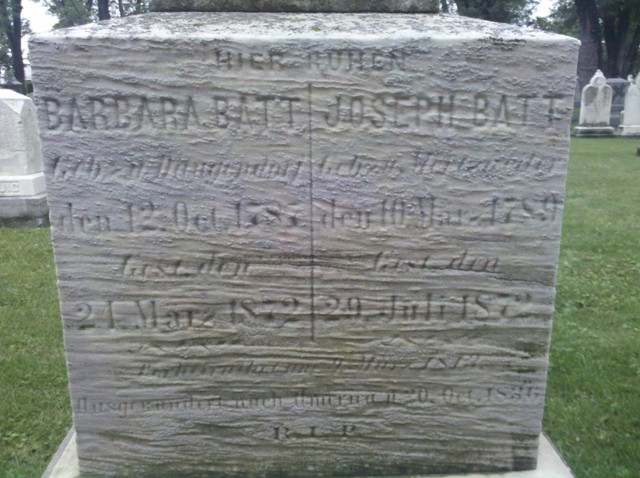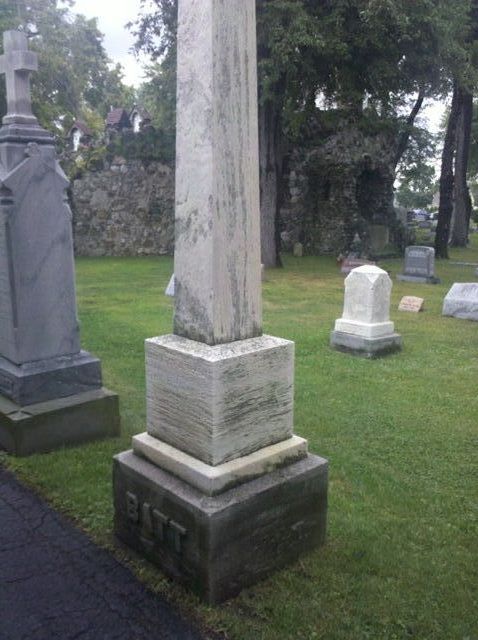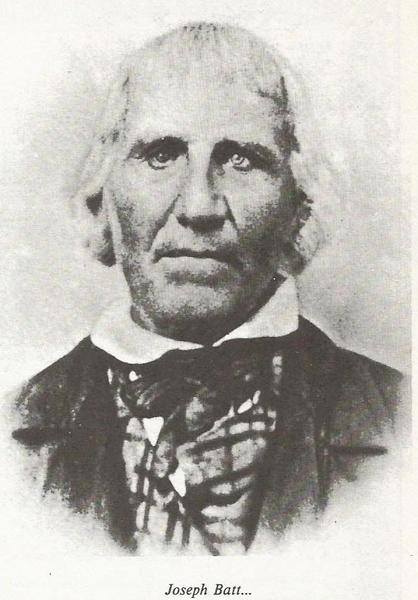Franz Joseph Batt, the only child of Michael Batt and Maria Anna Diebold, was born on 10 May 1789 at Mertzweiler, Alsace, and was baptized in the parish on the same day. He was to use his full name only on formal occasions, and dropped the "Franz" entirely after arriving in America. Shortly after Franz Joseph Batt was born, his father fled to Germany with him and his wife, Maria Anna, along with other Alsatians, after the outbreak of the French Revolution. His father, Michael Batt, was never to return. Family legend has it that he was killed by a soldier and his wife robbed. Franz Joseph Batt returned to Alsace with his widowed mother, and settled at Morschweiler, where she brought a house on 9 Floreal IX (1800). There he trained to be a stone mason, the occupation of his father, while he also engaged in farming. On 9 March 1813, Franz Joseph Batt was married at the parish church to Barbara Weber of Daugendorf. She was born on 12 October 1787, the daughter of Anton Weber, a farmer at Daugendorf, and his wife Barbara Schalk. Thus began a remarkable partnership which was to last early sixty years. All of Franz Joseph Batt's undertakings were actively supported and encouraged by his wife. Though illiterate, like most other women of her day, she was gifted with a peasant shrewdness and an amazing strength of character. In the first few years of their married life, Joseph and Barbara Batt witness the defeat of Napolean, the restoration of the Bourbon monarchy, Napolean's return from exile and the Hundred Days, his final defeat at Waterloo and a second restoration of the Bourbon monarchy. Thereafter France enjoyed a fifteen year period of relative political stability. During this time, the Batt family grew and prospered. Eleven children were born, two dying in infancy. Joseph Batt became a prosperous farmer, accumulating in the twenty year after his marriage many pieces of valuable property in and around Morschweiler. (The house is still known among the villagers, there as "S'Batt"--the house of the Batts, and the inscription of "JB 1816 BW" is still to be seen.)
In 1830, French political stability began to fall apart again. Franz Joseph Batt was already forty in 1829. His children were growing and he would soon be faced with providing a livelihood or lands for each of them. Although prosperous, his means would not be sufficient to provide for such a large family. He had no close living relatives, his mother had died on 30 March 1829. Without a father, brothers, or sisters, his widowed mother must have had a very strong influence on him. He death released him from a strong personal ties to the homeland, and must have heightened his growing sense of the passage of time, of his own future, and his responsibility for the future of the next generation.
By 1835, Franz Joseph Batt, sent his oldest son, Joseph Jr., to America to seek a new location for the family. After visiting Williamsville, New York, where a number of their former neighbors had already settled, he travelled through OH, Indiana, and Illinois, and then returned to Western New York, his choice for the new location of the Batt Family. In Alsace, Franz Joseph Batt was making preparations to immigrate.
On 20 October 1836, Franz Joseph and Barbara Batt, their eight surviving children, son-in-law Franz Joseph Gangloff, and their first surviving grandchild, John Gangloff, left their home forever, bound for the port of LeHavre. His passport was endorsed there by the prefect of police on 7 November 1836, and four days later, they sailed for New York.
On 11 November 1836, the Batt family left LeHavre aboard the "Mary Ann", an American vessel under the command of Captain Arthur Child. It had been built by Joseph Clark, the first full-rigged ship built at the Waldoboro Maine, Shipyard, and registered on 28 October 1835. On 29 November 1836, in longitude 22, the ship was suddenly hit by a violent tropical storm of hurricane severity. During the fury of the storm, the "Mary Ann" was stripped of sails, lost several masts, and began to leak dangerously. In this hour of extreme peril, Franz Joseph Batt turned to the Blessed Virgin to safeguard the journey of his family. Invoking the name of Our Lady Help of Christians, Star of the Sea, he made a solemn vow that if he and his family were to arrive safely in America, he would building a chapel there in her honor. When the storm abated, the ship was able to limp back to Cork, Ireland, from where it was reported on 2 December having put in "leaky, and with loss of mizzenmast, etc." (Times, 6 December). After repairs, and the disembarkation of several doubtless frightened passengers, the ship once again sailed for New York, whe3e it finally arrived on 2 February 1837, 84 days out of LeHavre, with 129 passengers.
After a trip across New York State, the new arrivals joined Joseph Jr. According to one family legend, the family arrived after a three-week journey on the Erie Canal. Joseph Batt Sr. immediately set about settling his family in a new home. On 2 June 1837, he purchased 138 acres from the Holland Land Company, for the sum of $859.84. This tract was situated in what was then the Town of Amherst, but was included in the new Town of Cheektowaga upon its creation shortly thereafter.
In 1851, circumstances at last permitting, Joseph Batt Sr. turned to the fulfillment of his vow to build a chapel. On 5 May 1851, he deeded three acres to Bishop Timon of Buffalo for the purpose of establishing a chapel, schoolhouse, and cemetery. The building was constructed of brick, which Joseph Batt Sr. made himself, and was finally blessed on 7 October 1851, and dedicated to "Maria Hilf"--Our Lady Help of Christians. This Chapel still stands and was designated a National Historic Site by the U. S. Department of Interior on 14 December 1978.
After the building of this chapel, Joseph Batt Sr., mindful of his advancing
years, made provision for his retirement and the support of himself and his wife in their old age. Following the old Alsatian custom, as witness his marriage contract of forty years before, he entered into a contract on 25 October 1853, with his sons, John, Anthony, and Xavier. In this contact, Joseph Sr. and his wife, Barbara, divided their farm between the three sons in exchange for their maintenance in old age. In 1863, Joseph and Barbara Batt celebrated their fiftieth wedding anniversary, surrounded by their large and loving family of children and grandchildren.
During their advance years, Joseph Sr., and Barbara must have looked with pride on their accomplishments in the new world. Secure and comfortable, they had helped two daughters and their husbands establish themselves on farms in the Midwest, and they lived surrounded by their other children, all equally well established and prosperous. And the Chapel which they had found not only stood as a solid proof of their devotion to the Blessed Virgin, and of the fulfillment of his vow to her, but had grown to become a place of devotion for their neighbors and countless pilgrims.
Nothing is known of Joseph Batt Sr.'s education beyond the facts that he was literate, he owned a number of German prayer books and devotionals, wrote in a better-than-average German script, and kept some records. From this, it can be surmised that he received a village or church-school education. The fact that he invariably used the old German script would rule out any familiarity with Latin or French. This lack of familiarity with French placed him out of the cultural mainstream of his own country in Alsace. In Western New York, Batt would be called German. He spoke Alsatian, a German dialect, the language of the peasantry. Batt was literally right at home in the Williamsville parish, for not only was most of the parish Alsatian, but many had come from his own region and village, and some were even his cousins. Batt's achievements were the result not of intellectual attainments, but were due entirely to a peasant's shrewdness, adaptability, and patient determination.
In the last years, Joseph Batt Sr. became blind, but he continued to frequent the Chapel, following a deeply-worn path from his own house, and once there, finding his own seat by feeling for a nail on the end of the pew. Barbara Batt died on 25 February 1872, at the age of 84, and her husband followed her on 29 July 1872, at the age of 83. Both lie buried in the Chapel cemetery, immediately behind the little brick Chapel which new serves as a sanctuary of the present structure. Their institution of the Chapel keeps their memory green.
Franz Joseph Batt, the only child of Michael Batt and Maria Anna Diebold, was born on 10 May 1789 at Mertzweiler, Alsace, and was baptized in the parish on the same day. He was to use his full name only on formal occasions, and dropped the "Franz" entirely after arriving in America. Shortly after Franz Joseph Batt was born, his father fled to Germany with him and his wife, Maria Anna, along with other Alsatians, after the outbreak of the French Revolution. His father, Michael Batt, was never to return. Family legend has it that he was killed by a soldier and his wife robbed. Franz Joseph Batt returned to Alsace with his widowed mother, and settled at Morschweiler, where she brought a house on 9 Floreal IX (1800). There he trained to be a stone mason, the occupation of his father, while he also engaged in farming. On 9 March 1813, Franz Joseph Batt was married at the parish church to Barbara Weber of Daugendorf. She was born on 12 October 1787, the daughter of Anton Weber, a farmer at Daugendorf, and his wife Barbara Schalk. Thus began a remarkable partnership which was to last early sixty years. All of Franz Joseph Batt's undertakings were actively supported and encouraged by his wife. Though illiterate, like most other women of her day, she was gifted with a peasant shrewdness and an amazing strength of character. In the first few years of their married life, Joseph and Barbara Batt witness the defeat of Napolean, the restoration of the Bourbon monarchy, Napolean's return from exile and the Hundred Days, his final defeat at Waterloo and a second restoration of the Bourbon monarchy. Thereafter France enjoyed a fifteen year period of relative political stability. During this time, the Batt family grew and prospered. Eleven children were born, two dying in infancy. Joseph Batt became a prosperous farmer, accumulating in the twenty year after his marriage many pieces of valuable property in and around Morschweiler. (The house is still known among the villagers, there as "S'Batt"--the house of the Batts, and the inscription of "JB 1816 BW" is still to be seen.)
In 1830, French political stability began to fall apart again. Franz Joseph Batt was already forty in 1829. His children were growing and he would soon be faced with providing a livelihood or lands for each of them. Although prosperous, his means would not be sufficient to provide for such a large family. He had no close living relatives, his mother had died on 30 March 1829. Without a father, brothers, or sisters, his widowed mother must have had a very strong influence on him. He death released him from a strong personal ties to the homeland, and must have heightened his growing sense of the passage of time, of his own future, and his responsibility for the future of the next generation.
By 1835, Franz Joseph Batt, sent his oldest son, Joseph Jr., to America to seek a new location for the family. After visiting Williamsville, New York, where a number of their former neighbors had already settled, he travelled through OH, Indiana, and Illinois, and then returned to Western New York, his choice for the new location of the Batt Family. In Alsace, Franz Joseph Batt was making preparations to immigrate.
On 20 October 1836, Franz Joseph and Barbara Batt, their eight surviving children, son-in-law Franz Joseph Gangloff, and their first surviving grandchild, John Gangloff, left their home forever, bound for the port of LeHavre. His passport was endorsed there by the prefect of police on 7 November 1836, and four days later, they sailed for New York.
On 11 November 1836, the Batt family left LeHavre aboard the "Mary Ann", an American vessel under the command of Captain Arthur Child. It had been built by Joseph Clark, the first full-rigged ship built at the Waldoboro Maine, Shipyard, and registered on 28 October 1835. On 29 November 1836, in longitude 22, the ship was suddenly hit by a violent tropical storm of hurricane severity. During the fury of the storm, the "Mary Ann" was stripped of sails, lost several masts, and began to leak dangerously. In this hour of extreme peril, Franz Joseph Batt turned to the Blessed Virgin to safeguard the journey of his family. Invoking the name of Our Lady Help of Christians, Star of the Sea, he made a solemn vow that if he and his family were to arrive safely in America, he would building a chapel there in her honor. When the storm abated, the ship was able to limp back to Cork, Ireland, from where it was reported on 2 December having put in "leaky, and with loss of mizzenmast, etc." (Times, 6 December). After repairs, and the disembarkation of several doubtless frightened passengers, the ship once again sailed for New York, whe3e it finally arrived on 2 February 1837, 84 days out of LeHavre, with 129 passengers.
After a trip across New York State, the new arrivals joined Joseph Jr. According to one family legend, the family arrived after a three-week journey on the Erie Canal. Joseph Batt Sr. immediately set about settling his family in a new home. On 2 June 1837, he purchased 138 acres from the Holland Land Company, for the sum of $859.84. This tract was situated in what was then the Town of Amherst, but was included in the new Town of Cheektowaga upon its creation shortly thereafter.
In 1851, circumstances at last permitting, Joseph Batt Sr. turned to the fulfillment of his vow to build a chapel. On 5 May 1851, he deeded three acres to Bishop Timon of Buffalo for the purpose of establishing a chapel, schoolhouse, and cemetery. The building was constructed of brick, which Joseph Batt Sr. made himself, and was finally blessed on 7 October 1851, and dedicated to "Maria Hilf"--Our Lady Help of Christians. This Chapel still stands and was designated a National Historic Site by the U. S. Department of Interior on 14 December 1978.
After the building of this chapel, Joseph Batt Sr., mindful of his advancing
years, made provision for his retirement and the support of himself and his wife in their old age. Following the old Alsatian custom, as witness his marriage contract of forty years before, he entered into a contract on 25 October 1853, with his sons, John, Anthony, and Xavier. In this contact, Joseph Sr. and his wife, Barbara, divided their farm between the three sons in exchange for their maintenance in old age. In 1863, Joseph and Barbara Batt celebrated their fiftieth wedding anniversary, surrounded by their large and loving family of children and grandchildren.
During their advance years, Joseph Sr., and Barbara must have looked with pride on their accomplishments in the new world. Secure and comfortable, they had helped two daughters and their husbands establish themselves on farms in the Midwest, and they lived surrounded by their other children, all equally well established and prosperous. And the Chapel which they had found not only stood as a solid proof of their devotion to the Blessed Virgin, and of the fulfillment of his vow to her, but had grown to become a place of devotion for their neighbors and countless pilgrims.
Nothing is known of Joseph Batt Sr.'s education beyond the facts that he was literate, he owned a number of German prayer books and devotionals, wrote in a better-than-average German script, and kept some records. From this, it can be surmised that he received a village or church-school education. The fact that he invariably used the old German script would rule out any familiarity with Latin or French. This lack of familiarity with French placed him out of the cultural mainstream of his own country in Alsace. In Western New York, Batt would be called German. He spoke Alsatian, a German dialect, the language of the peasantry. Batt was literally right at home in the Williamsville parish, for not only was most of the parish Alsatian, but many had come from his own region and village, and some were even his cousins. Batt's achievements were the result not of intellectual attainments, but were due entirely to a peasant's shrewdness, adaptability, and patient determination.
In the last years, Joseph Batt Sr. became blind, but he continued to frequent the Chapel, following a deeply-worn path from his own house, and once there, finding his own seat by feeling for a nail on the end of the pew. Barbara Batt died on 25 February 1872, at the age of 84, and her husband followed her on 29 July 1872, at the age of 83. Both lie buried in the Chapel cemetery, immediately behind the little brick Chapel which new serves as a sanctuary of the present structure. Their institution of the Chapel keeps their memory green.
Inscription
Geb Zu Mertzweiler. Ausgewandert nach Ameroca 10, 20, 1836
Family Members
-
![]()
Franz Joseph Batt Jr
1814–1899
-
![]()
Maria Anna Batt Gangloff
1815–1889
-
Stephen Batt
1817–1817
-
![]()
Anton "Anthony" Batt
1819–1896
-
![]()
Theresa Batt Schwartz
1821–1886
-
![]()
Barbara Batt Ottney
1823–1879
-
![]()
John Batt
1825–1880
-
Maria Josepha Batt
1828–1832
-
![]()
Francisca "Frances" Batt Daul
1830–1907
-
![]()
Xavier Batt
1832–1913
-
![]()
Richardus Batt Haas
1834–1898
